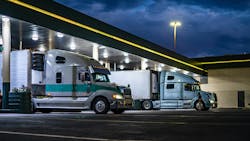Reefer Outlook: Carriers cautious despite expert’s optimism
Key Highlights
- Political shifts, including deregulation and tax cuts, are viewed as potential catalysts for industry growth in the coming years.
- Overcapacity and tariff-related uncertainties continue to suppress freight rates, complicating profitability for refrigerated carriers.
- Consumer trends like farm-to-table sourcing and remote work are reshaping long-haul reefer logistics, reducing demand for traditional transportation routes.
- Reefer demand has remained relatively stronger than dry van, but unique challenges such as health medication trends are impacting freight volumes.
- Industry experts suggest that resolving tariff issues and easing interest rates could accelerate market recovery and improve margins.
John Larkin, a strategic advisor with Clarendon Capital, tried to introduce a little bit of optimism into his refrigerated market outlook during the Truckload Carriers Association’s 2025 Refrigerated Meeting, pointing to developments in Washington that bode well for trucking, including deregulation, tax cuts in the Big Beautiful Bill, and industrial onshoring incentivized by tariffs.
“The political winds have shifted in the last 18 months or so—pretty dramatically in the right direction, in my opinion,” Larkin said July 16 at the Polaris Hotel in Colorado Springs, Colorado.
But executives with three leading refrigerated carriers remained unmoved.
Still mired in a historic freight recession, they’re far too preoccupied with persistent problems to ponder any potential future gains. A stubborn surplus in capacity continues to suppress rates, which aren’t keeping up with operational costs amid tariff-induced uncertainty, panelists agreed; and, more pertinently for refrigerated fleets, the farm-to-table and work-from-home trends, and shift in produce sourcing, are indelibly altering the long-haul reefer landscape.
“No one aspect has played the biggest part [in the freight recession], but all of them together are causing everyone in the industry to step back and ask, ‘Is this the new normal?’” shared Sam Anderson, Bay and Bay Transportation president and CEO. “That’s what we’re doing at our company. I’m expecting, and planning for, the market not to change the next two years. So, we’ve focused on getting our costs in line through a variety of different methods.”
Recent reports, however, seem to validate Larkin’s enduring enthusiasm.
Total spot load activity increased 5.9% and broker-reported refrigerated spot rates increased by 2.1 cents in the final week of July, leaving them about 2% higher than in the same week in 2024, according to new data from FTR and Truckstop.com. And 85% of carriers still believe volumes will increase or hold firm in the second half of 2025, according to a new survey by Truckstop.com and Bloomberg. “Many carriers and brokers remained optimistic through the first half of 2025, despite facing difficulties,” Todd Markusic, Truckstop.com customer insights manager, said in a news release. “While the freight market underperformed in the second quarter—with no clear resolution for how tariffs will impact the economy—many in the industry are expecting a recovery in the next six months.”
Long-term gains?
Larkin’s outlook is buoyed by a belief that the Trump administration’s moves through the first half of the year will benefit the overall trucking industry. “Historically, the Congressional Budget Office always underestimates the amount of economic growth created by lower taxes and pro-business policies, and I think that will be the case this time around,” he argued. The long-term “stimulative impact” of those moves will include bringing manufacturing outsourced to other countries back to the United States, he said. “At the end of the day, industrial production is the variable most highly correlated with trucking volume,” Larkin said.
“It’s difficult to have a strong trucking environment with flat industrial economy.”
He also pointed to the federal government’s tariff-aided $27 billion budget surplus in June—its first June surplus since 2017—but Marten Transport CEO Tim Kohl wasn’t swayed. “Consumers are going to pay for that,” Kohl countered.
“The tariffs are utterly insane. Our industry can’t afford the tractors now.”
Kohl concurred with Larkin’s assessments of the labor market, which remains tight, and inflation, which is frustratingly persistent. And while Larkin acknowledged tariff uncertainty is slowing trucking’s recovery, he insisted cutting the interest rate—an action Federal Reserve Chair Jerome Powell has refused to take with inflation still hovering at 2.7% in July—would fuel the economy by boosting the housing market, particularly when it comes to new builds.
“Interest rates are too high,” Larkin said. “They’re discouraging investments, which reduces freight volumes.”
Lingering overcapacity is complicating stagnant freight demand, he added, blaming brokers’ quick-pay programs and financiers’ leniency for allowing “fly-by-night” operators to hang on; and Wendell Erb, president and CEO of Erb Transport, agreed. “If financiers bring trucks back, they’re just going to dump them and take the loss,” Erb said. “So, rather than taking a big loss at an auction sale, and writing off the equipment, they’re letting those guys keep going.”
Short-term frustration?
Reefer demand has held stronger than dry van demand, Larkin said, citing data from Morgan Stanley Research. Spot reefer rates haven’t fared as well, “but the last couple of months have looked better, which may indicate some tightening of supply and demand,” he added; and FTR’s July data support that notion. But reefer carriers also face unique challenges—including the growing popularity of appetite-reducing GLP-1 medications like Ozempic. “This is having a big impact on the volume of freight moving in the refrigerated sector,” Larkin asserted.
“It’s a very interesting phenomenon.”
The farm-to-table and work-from-home trends are also reshaping reefer logistics.
Restaurants offering freshly harvested food will source 35% of their ingredients from local farms this year, up from 12% in 2020, according to a Metrobi report. “This trend is not fully played out,” Larkin predicted. “You’re going to see more and more local sourcing in the search for freshness, and that’s going to have a negative impact on long-haul transportation.” At the same time, more U.S. fruits and vegetables are coming from centrally located farms in Mexico, according to the USDA; and, to a lesser extent, Texas. “California used to be the be-all, end-all for produce, creating a huge amount of long-haul opportunity,” he said.
The increase in people working from home is reducing restaurant consumption, particularly in big cities, Larkin said. Inflation is exacerbating the issue, leaving people with less disposable income, Kohl added. “We saw better grocery business from the big grocers [in July] than we had been seeing, but the restaurant business is still tailing off,” he noted. “And that will continue because people can’t afford to eat out. They’ve got to cut their budget somewhere.”
Is this the new normal?
Reefer carriers are doing their best to adjust to market dynamics, but they can only optimize operations to a certain level, panelists agreed. Now they need shippers to help make margins more manageable. “We started raising rates the first part of this year,” Anderson said. “You get to a point where you can only get costs so low before you have to go to your customer and say, ‘This is our cost to operate—and we can’t reduce driver pay by 10 to 15 cents a mile.”
Marten’s second-quarter earnings report, released the same day of the reefer outlook discussion, showed its tractor costs increased 17% from 2021—before any new tariffs that could be coming—refrigerated trailers costs rose 30%, and tractor depreciation accelerated from Q1; all while maintenance costs, including parts and labor, have continued to climb since Covid. “In 2022, maintenance costs ate up 5% of our revenue,” he said. “Now it’s 7%.”
Carriers also are reducing layovers and empty miles, and trying hard to maintain fuel surcharges even while improving fuel efficiency, to protect profitability. “I don’t know if this is the new normal, but you’ve got to treat it like that,” Kohl said.
“If you don’t, you won’t make any money.”
That’s why Kohl’s taking a “wait-to-see” approach in Q4, even if signs are pointing to an eventual end of a painful freight recession.
“Most freight recessions last 14 months,” Larkin concluded. “This one has lasted more than 36 months—almost three times as long—but hopefully, we’re getting close to the end. If we can get the tariff uncertainty resolved, we should be off to the races. A couple of interest rate cuts from the Fed would really help, and surplus capacity should be exiting the market as trucks age out, and financiers pull collateral as used-truck values increase. So, I’m hopeful next year’s economic update is a lot more positive—and we’re rolling full steam at that point.”
About the Author

Jason McDaniel
Jason McDaniel, based in the Houston TX area, has nearly 20 years of experience as a journalist. He spent 15 writing and editing for daily newspapers, including the Houston Chronicle, and began covering the commercial vehicle industry in 2018. He was named editor of Bulk Transporter and Refrigerated Transporter magazines in July 2020.


